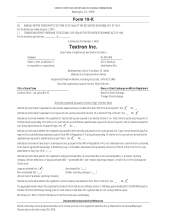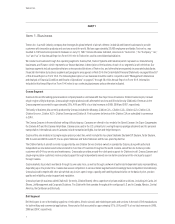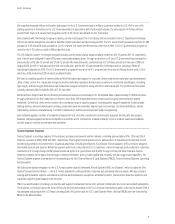E-Z-GO 2009 Annual Report Download - page 19
Download and view the complete annual report
Please find page 19 of the 2009 E-Z-GO annual report below. You can navigate through the pages in the report by either clicking on the pages listed below, or by using the keyword search tool below to find specific information within the annual report.
10
Item 1A. Risk Factors
Cost overruns on U.S. Government contracts could subject us to losses or adversely affect our future business.
Contract and program accounting require judgment relative to assessing risks, estimating contract revenues and costs, and making assumptions
for schedule and technical issues. Due to the size and nature of many of our contracts, the estimation of total revenues and cost at completion is
complicated and subject to many variables. Assumptions have to be made regarding the length of time to complete the contract because costs
include expected increases in wages and prices for materials. Incentives or penalties related to performance on contracts are considered in
estimating sales and profit rates and are recorded when there is sufficient information for us to assess anticipated performance. Estimates of
award fees also are used in estimating sales and profit rates based on actual and anticipated awards. Because of the significance of these
estimates, it is likely that different amounts could be recorded if we used different assumptions or if the underlying circumstances were to change.
Changes in underlying assumptions, circumstances or estimates may adversely affect our future financial results of operations.
Under fixed-price contracts, we receive a fixed price irrespective of the actual costs we incur, and, consequently, any costs in excess of the fixed
price are absorbed by us. Under time and materials contracts, we are paid for labor at negotiated hourly billing rates and for certain expenses.
Under cost-reimbursement contracts, which are subject to a contract-ceiling amount, we are reimbursed for allowable costs and paid a fee, which
may be fixed or performance based. However, if our costs exceed the contract ceiling or are not allowable under the provisions of the contract or
applicable regulations, we may not be able to obtain reimbursement for all such costs. Under each type of contract, if we are unable to control
costs we incur in performing under the contract, our financial condition and results of operations could be adversely affected. Cost overruns also
may adversely affect our ability to sustain existing programs and obtain future contract awards.
Developing new products and technologies entails significant risks and uncertainties.
To continue to grow our revenues and segment profit, we must successfully develop new products and technologies or modify our existing
products and technologies for our current and future markets. Our future performance depends, in part, on our ability to identify emerging
technological trends and customer requirements in our current and future markets and to develop and maintain competitive products and
services. Delays or cost overruns in the development and acceptance of new products, or certification of new aircraft products and other products,
could affect our financial results of operations. These delays could be caused by unanticipated technological hurdles, production changes to meet
customer demands, unanticipated difficulties in obtaining required regulatory certifications of new aircraft products, coordination with joint
venture partners or failure on the part of our suppliers to deliver components as agreed. We also could be adversely affected if the general efficacy
of our research and development investments to develop products is less than expected or if we do not adequately protect the intellectual property
developed through our research and development efforts. Furthermore, because of the lengthy research and development cycle involved in
bringing certain of our products to market, we cannot predict the economic conditions that will exist when any new product is complete. A
reduction in capital spending in the aerospace or defense industries could have a significant effect on the demand for new products and
technologies under development, which could have an adverse effect on our financial condition and results of operations. In addition, there can be
no assurance that the market for our offerings will develop or continue to expand as we currently anticipate. Furthermore, we cannot be sure that
our competitors will not develop competing technologies which gain market acceptance in advance of our products. Our failure in our new
product development efforts or the failure of our products or services to achieve market acceptance more rapidly than our competitors could have
an adverse effect on our financial condition and results of operations.
Our joint venture, teaming and other arrangements involve risks and uncertainties.
We have entered, and expect to continue to enter, into joint venture, teaming and other arrangements, and these activities involve risks and
uncertainties, including the risk of the joint venture or related business partner failing to satisfy its obligations, which may result in certain
liabilities to us for guarantees and other commitments; the challenges in achieving strategic objectives and expected benefits of the business
arrangement; the risk of conflicts arising between us and our partners and the difficulty of managing and resolving such conflicts; and the
difficulty of managing or otherwise monitoring such business arrangements.
We may make acquisitions and dispositions that increase the risks of our business.
We may enter into acquisitions or dispositions in the future in an effort to enhance shareholder value. Acquisitions or dispositions involve a
certain amount of risks and uncertainties that could result in our not achieving expected benefits. With respect to acquisitions, such risks include
difficulties in integrating newly acquired businesses and operations in an efficient and cost-effective manner; challenges in achieving expected
strategic objectives, cost savings and other benefits; the risk that the acquired businesses’ markets do not evolve as anticipated and that the
technologies acquired do not prove to be those needed to be successful in those markets; the risk that we pay a purchase price that exceeds what
the future results of operations would have merited; and the potential loss of key employees of the acquired businesses. With respect to
dispositions, the decision to dispose of a business or asset may result in a writedown of the related assets if the fair market value of the assets,
less costs of disposal, is less than the book value. In addition, we may encounter difficulty in finding buyers or alternative exit strategies at
























